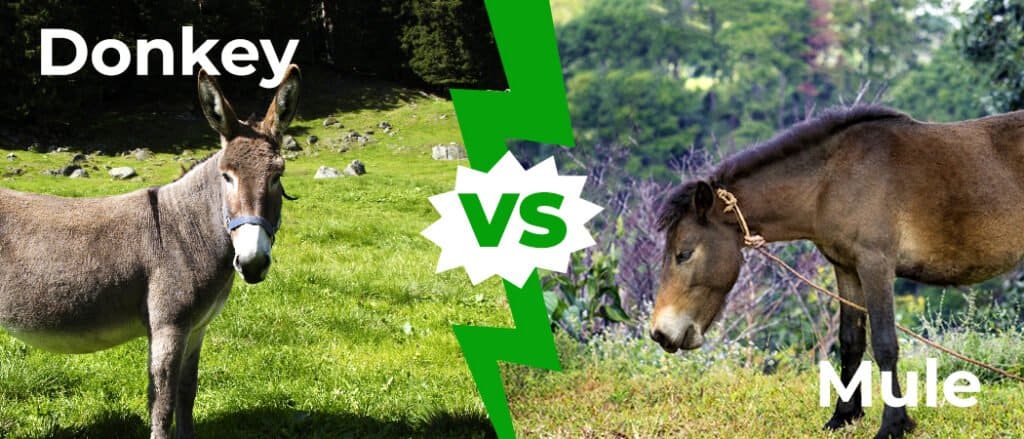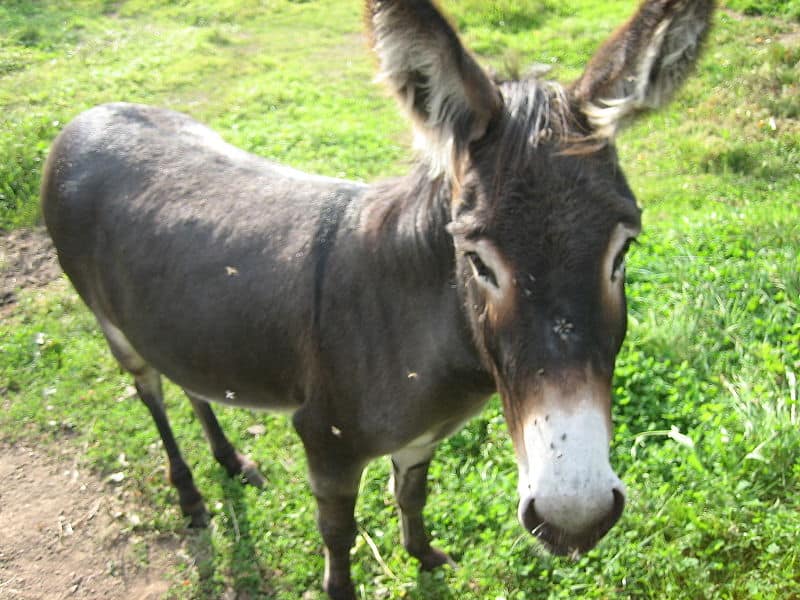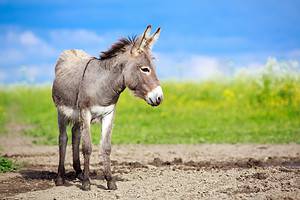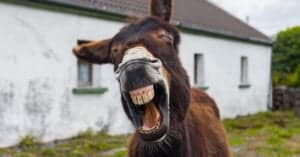Donkeys and mules are both hoofed mammals, and can easily be confused due to their similarities. Donkeys are members of the horse family, Equidae, and were first domesticated in Africa between 5,000 and 6,000 years ago. Mules are the hybrid offspring of a male donkey and a female horse and have been common since around 3,000BC.
Considering that mules have a donkey parent, it is to be expected that they share some characteristics with donkeys. However, there are some noticeable (and not so noticeable) differences between the two. For a start, their ears and tails are different, as is their height. One has a really distinctive cross marking on it’s back, while the other doesn’t. Not to mention that one of the most important differences is that one can reproduce and one can’t. However, there is much more to learn about these fascinating animals, so join us as we explore all of the key differences between donkeys and mules.
Comparing Mule vs Donkey

Donkeys and mules have both been used as pack animals to transport goods and cargo in harsh conditions in places such as Africa, Afghanistan, and Egypt for thousands of years. As mules are the offspring of a male donkey and a female horse, it’s understandable that they share a lot of traits with donkeys. However, something called “hybrid vigor” means that they actually share some of the best traits of both parents, which means that they are an interesting mix of the two, while still being uniquely different.
Check out the chart below to learn a few of the main differences between mule vs donkey.
| Mule | Donkey | |
| Size | 48 to 68 inches at the shoulder | 36 to 48 inches at the shoulder |
| Body Shape | Short head, thin legs, wider hooves, horse-shaped neck. Color can vary as often take after horse parent | Short, thick head, short mane, thin legs, narrow hooves. Color usually grey, brown, or black |
| Ears | Smaller than donkey ears but shaped like horse ears | Large and long |
| Tail | Horse tail – long hairs falling down from the tail bone | Cow-like tail – long and thin with tuft of hair on the end |
| Cross | No cross | Dark stripe from head, down back and across shoulders, forming a cross |
| Sound | A cross between a horse’s whinney and a donkey’s bray | Bray |
| Fertility | Infertile – cannot reproduce at all | Can reproduce |
| Chromosomes | 63 | 62 |
| Jumping | Can jump up several feet from a standing position | Cannot jump up |
| Lifespan | 30 to 40 years | 30 to 50 years |
The 5 Key Differences Between Mule vs Donkey
Donkey vs Mule: Size

Donkeys are relatively small and usually don’t reach more than 48 inches at the shoulder
One of the major differences between mule vs donkey is their size. Donkeys are fairly small and most only reach between 36 and 48 inches at the withers (shoulders) – 9 to 12 hands high in horse language. Even the largest breed of donkey, American Mammoth donkeys, only reach around 56 inches.
Horses are much taller and heavier than donkeys. Therefore, as mules come from horses as well as donkeys, they are also much bigger than donkeys. Most mules stand between 48 and 68 inches at the withers (12 to 17hh).
Donkey vs Mule: Body Shape
Donkeys typically have a short thick head and a short mane. They also have fairly thin legs and narrow hooves which are more oval-shaped than horses feet. Donkey’s feet are extremely tough as they have adapted to the harsh, dry environment that many donkeys live in while walking long distances, often while carrying heavy loads. Donkeys are usually grey, brown, or black. They all have the distinctive cross marking which consists of a dark stripe down their neck from their head and along their back, and a stripe across the shoulders.
Mules are an interesting mix of features from both their horse and donkey parents. They have the short thick head which is a characteristic of the donkey, along with the short mane and thin legs. However, their necks and bodies are shaped more like those of horses. Mules also have hooves that are wider and more round than those of donkeys, but less so when compared horses. Their coat color also usually takes after their horse parent, so color can vary. This also means that they can even be mixed colors, such as black and white, or brown and white, or be a solid color with white markings, just like horses.
Donkey vs Mule: Ears
Donkeys have long been famous for their extraordinarily large ears which often have dark markings on their edges. However, their large ears aren’t just for show. They have a really important role, which is to help donkeys hear sounds from a long way. Incredibly, donkeys can hear the call of another donkey as far as 60 miles away. They need to be able to hear over such long distances because donkeys often live in hot climates where food is scarce. So they often spread out over a large area while looking for food.
On the other hand, mules have ears that are noticeably smaller than donkeys ears but still considerably larger than horses ears while still shaped the same as horses.
Donkey vs Mule: Tail
It would be easy to assume that donkeys and horses (and therefore mules) have the same sort of tails. However, donkeys and horses actually have completely different tails. Mules usually inherit the long, flowing tail from their horse parent. Mules tails consist of long strands of coarse hair which grow from and fall down from the dock, which is the tail bone. This tail bone allows them to swish their tail and flick the long strands of horse hair around their sides and rump, which is often an excellent way to remove any pesky flies.
When you look closer at a donkey’s tail, you will see that it is actually completely different and closely resembles that of a zebra or a cow. Donkey tails are long and thin and have a tuft of hair on the end rather than long hairs that fall all the way down.
Donkey vs Mule: Fertility
One of the most major differences between mule vs donkey, albeit one that we cannot see, is their ability to reproduce. Donkeys, just like horses, are fertile and can reproduce either with themselves or with a horse. However, mules cannot reproduce. This is because they are a hybrid, which is a cross between two different species. Mules are infertile and are not able to reproduce at all – either with other mules or with donkeys or horses.

Mules are nearly always infertile and unable to reproduce
©slowmotiongli/Shutterstock.com
FAQ’s (Frequently Asked Questions)
What are hinnys and how are they different to mules?
Just like mules, hinnys are a hybrid of a horse and a donkey. However, while mules are the offspring of a male donkey and a female horse, hinnys are the opposite – the offspring of a male horse and a female donkey. There are a few differences between mules and hinnys, the most noticeable being size. Because their donkey mothers are smaller than horses, hinnys are usually smaller than mules which are from horse mothers. Additionally, their temperament is more like that of a donkey, which is often attributed to the fact that they are raised by a donkey mother rather than a horse mother.
Are mules as strong as donkeys?
Mules are generally tougher and stronger than donkeys. This is in part because they are larger, but also because of something called “hybrid vigor”. Hybrid vigor is when cross breeding two species removes the weaker characteristics but passes on the desirable ones. As mules are stronger, they are generally preferred over donkeys for use as pack animals as they can carry greater weight and have greater endurance than either of their parents. They are also more patient in temperament when carrying heavy loads.
Can you ride a mule?
Yes, you can ride mules and they are often extremely capable and well suited to being ridden.
Is the saying “as stubborn as a mule” true?
The term “as stubborn as a mule” has often been used worldwide and generally accepted as fact. However, there is actually little truth in it. Despite the label that they have been stuck with, mules are less stubborn than donkeys and are very intelligent. Mules have a lot of common sense and have a very strong sense of self-preservation, which means that caution has likely been mistaken for stubbornness.
What Is a Molly Mule and Can It Reproduce?

A female mule is often referred to as a Molly mule.
©slowmotiongli/Shutterstock.com
A female mule is sometimes referred to as a Molly mule, while a male is called a John mule. John mules are sterile and cannot reproduce offspring. Though very rare, however, it is possible for Molly mules to become pregnant and reproduce. A fertile Molly can be mated with a male horse or donkey.
While there have been documented claims of Mollies, as well as hinnies, giving birth, scientists have usually viewed the claims with skepticism. But in China, mules have been bred and utilized as work animals regularly, and as a result, there are two records now–one of a female mule and one of a female hinny–giving birth to a filly after having been mated with male donkeys. What’s even more fascinating is that researchers found that the foals possessed unique hybrid karyotypes.
The photo featured at the top of this post is © iStock.com/tepic
Thank you for reading! Have some feedback for us? Contact the AZ Animals editorial team.







